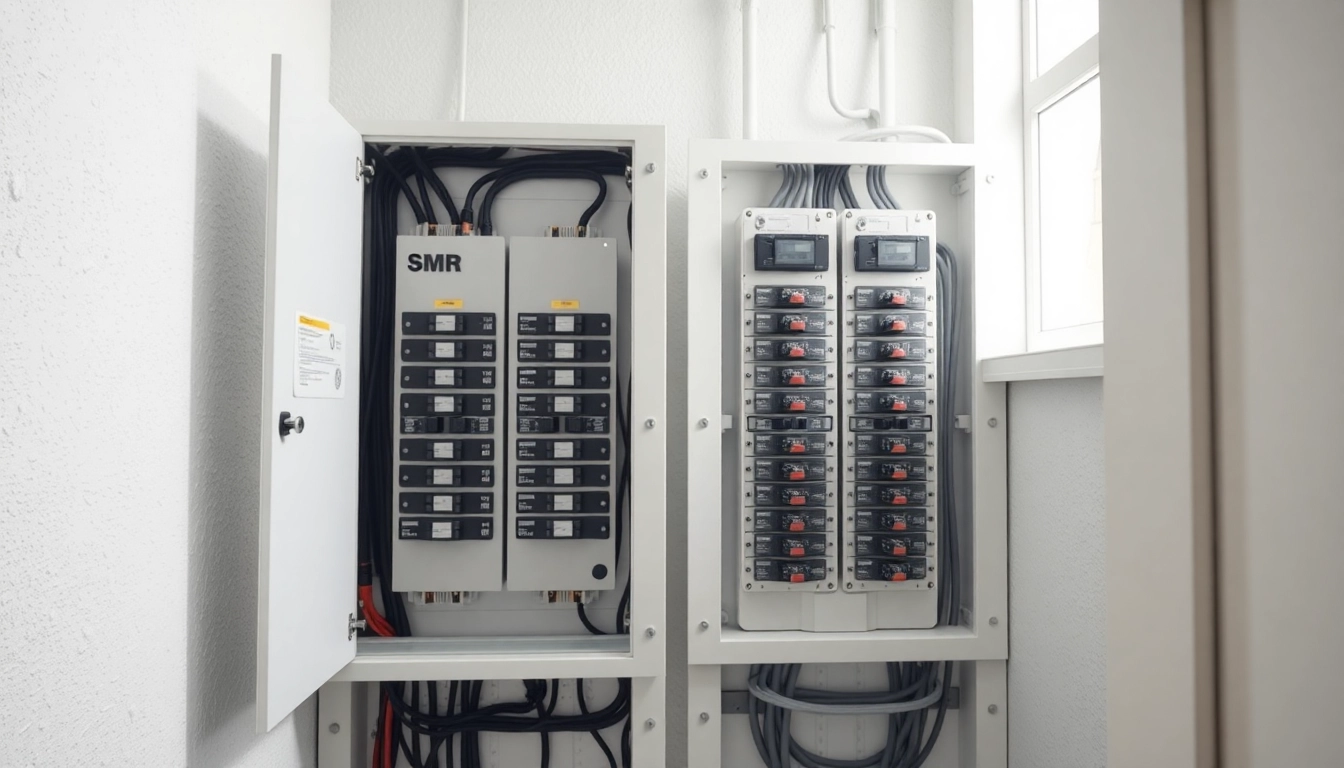1. What is an Electrical Panel?
1.1 Definition of Electrical Panels
An electrical panel, also known as a breaker box or distribution board, serves as the central hub that distributes electrical power throughout a building. It connects the main power supply from the utility company to various circuits that run the lights, outlets, and appliances within a home or commercial setting. Essentially, it acts as the nerve center of a building’s electrical system, controlling the flow of electricity and ensuring that it is safely redirected where needed.
1.2 Components of an Electrical Panel
Understanding the key components of an electrical panel is crucial for homeowners and business owners alike. The main components include:
- Busbars: These metal strips conduct electricity and distribute it to individual circuit breakers.
- Circuit Breakers: These safety devices automatically stop the flow of electricity in case of overload, helping to prevent fire hazards.
- Main Disconnect Switch: This allows the entire electrical system to be turned off, providing safety and convenience during repairs or maintenance.
- Neutral and Ground Bars: These bars provide a point for connecting neutral wires and ground wires, respectively, which help in maintaining safety and proper grounding of the electrical system.
1.3 Types of Electrical Panels
Electrical panels can primarily be categorized into two types:
- Main Panels: Also called service panels, these are the primary distribution points for electricity and usually found in residential structures.
- Subpanels: These are smaller panels that are connected to the main panel and used to provide power to specific areas of the house or certain appliances, such as pools or garages.
Additionally, there are different configurations based on the voltage and amperage requirements, such as 100-amp, 200-amp, and 400-amp panels.”
2. Signs That It’s Time to Upgrade Your Electrical Panel
2.1 Frequently Tripped Breakers
One of the most telling signs that an electrical panel may be insufficient is the frequent tripping of circuit breakers. If you find that circuits frequently shut off, it could be indicative of overloading. Modern homes have significantly more electrical appliances than in the past, necessitating higher capacities than older panels can provide. A chronically tripping circuit is a symptom of underlying issues that should not be ignored as it endangers the safety of occupants.
2.2 Insufficient Power for Modern Needs
As technology evolves, so do our electrical needs. If you’re planning to install new appliances that require higher power levels, or if you have added more electronics like computers, smart TVs, and electric vehicles, an outdated electrical panel may not be able to support the demand. Homes built decades ago typically feature panels with 60 or 100 amps, which may no longer suffice with today’s requirements.
2.3 Age and Condition of the Electrical Panel
The age of an electrical panel plays a pivotal role in its performance and reliability. Electrical panels typically have a lifespan of 20 to 30 years. If your panel is approaching or exceeding this age, it may be time for an upgrade. Besides age, physical inspection can reveal issues such as rust, scorch marks, or damaged components, all of which indicate it’s time to replace the panel for safety reasons.
3. Benefits of Upgrading Your Electrical Panel
3.1 Enhanced Safety Features
Safety is paramount in any electrical system. Newer electrical panels feature state-of-the-art safety mechanisms that safeguard against overloads and short circuits. These panels often include ground fault circuit interrupters (GFCIs) and arc fault circuit interrupters (AFCIs), which enhance protection against electrical fires and shock hazards.
3.2 Increased Electrical Efficiency
Upgrading an electrical panel not only addresses safety concerns but can also lead to improved electrical efficiency. A modern panel can provide a clearer and more reliable distribution of power, which minimizes energy loss and can translate to lower electricity bills over time. This enhanced efficiency benefits both residential and commercial properties.
3.3 Better Support for Smart Home Technology
As technology advances, the integration of smart home devices has become more commonplace. These devices often require a considerable amount and consistent flow of electricity. An upgraded electrical panel can meet the demands of smart home technology effectively, ensuring continuous support for your home automation systems including smart thermostats, lighting, and security systems.
4. Steps to Upgrade Your Electrical Panel
4.1 Assessing Your Power Needs
The first step in considering an upgrade is to assess your power needs realistically. Conduct a thorough inventory of all electrical devices and appliances in your home, along with their amperage ratings. This assessment should guide decisions about whether to upgrade and to what capacity—100 amps, 200 amps, or more based on your future plans.
4.2 Hiring a Professional Electrician
Working with electrical panels involves inherent risks, and thus it’s critical to hire a qualified professional electrician. Not only can they provide expert insight on upgrading, but they understand local codes and regulations, ensuring that any work conducted is compliant and safe.
4.3 Understanding Costs Involved
Cost is a significant consideration when upgrading an electrical panel. Homeowners should budget for the panel itself, labor costs, and any necessary permits or inspections. Generally, replacement can range from $1,500 to $3,000 depending on the complexity of the installation and the required capacity, making it essential to plan effectively.
5. Maintaining Your Electrical Panel for Longevity
5.1 Regular Inspections and Tests
Routine inspections of your electrical panel can identify potential issues before they develop into serious problems. Homeowners should routinely check for signs of wear, such as malfunctioning breakers or unusual noises. Furthermore, consider having a qualified electrician perform more thorough inspections at least once every three to five years to ensure all components are functioning properly.
5.2 Cleaning and Upkeep
Dust and debris can accumulate inside electrical panels, which may interfere with performance. Regular cleaning, typically done by a qualified electrician, helps to maintain optimal functioning and extends the lifespan of the panel. It’s crucial to turn off the power before any cleaning process begins to ensure safety.
5.3 Knowing When to Seek Help
It’s vital to remain vigilant regarding your electrical panel. If you notice any odd behaviors like burning smells, flickering lights, or even if you just feel unsure about the panel’s performance, do not hesitate to contact a professional. Time is of the essence when it comes to electrical issues; delaying could result in larger and more costly problems.



